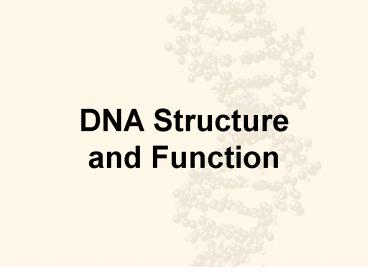DNA Structure and Function - PowerPoint PPT Presentation
1 / 30
Title:
DNA Structure and Function
Description:
It must contain information for ... However, it must be capable of mutational change. ... 'Frankenstein' fly 'extra' eye on the antennae 'extra' eye on the leg ... – PowerPoint PPT presentation
Number of Views:44
Avg rating:3.0/5.0
Title: DNA Structure and Function
1
DNA Structure and Function
2
DNA had been proven as the genetic material by
the Hershey-Chase experiments, but how DNA served
as genes was not yet certain.
- DNA must carry information from parent cell to
daughter cell. - It must contain information for replicating
itself. - It must be chemically stable, relatively
unchanging. - However, it must be capable of mutational change.
Without mutations there would be no process of
evolution.
- What is the structure of DNA?
- How does it replicate to ensure genetic
consistency? - How does it direct the synthesis of proteins?
- How are genes regulated?
3
Key Concepts
- DNA contains the information of heritable traits
in all cells - Each DNA strand consists of two strands of
nucleotides twisted together - Hereditary information is encoded in the sequence
of nucleotides - Nitrogen bases have specific pairing arrangements
- DNA is replicated before a cell divides
4
Gene Expression and Regulation
5
Concepts
- A gene is a relatively short sequence of DNA that
provides instruction (generally to form proteins)
2. Gene expression involves
transcription of a DNA sequence to RNA
followed by
translation of the RNA into amino acid sequence
of a protein
3. Gene expression is a regulated process.
4. Changes in DNA sequence are called mutation
and may alter the resulting protein produced
causing changed protein function.
6
(No Transcript)
7
The players
8
How to read the code
9
The Genetic Code
1 letter code 41 4 possible combinations
2 letter code 42 16 possible combinations
3 letter code 43 64 possible combinations
4 letter code 44 256 possible combinations
10
SHORT REVIEW
Gene expression the process of making proteins
from DNA code message
Protein synthesis two stepped process
TRANSCRIPTION, TRANSLATION
DNA ---- mRNA ---- protein
GENETIC CODE 3 letter code
GENETIC CODE degenerative ,
encoding for the 20 amino acids,
START code and STOP code
11
Transcription
12
RNA transcription
Location nucleus
13
SUMMARY Transcription
GOAL to send nucleotide message (encoded in DNA)
from nucleus to cytoplasm
DNA nucleotide sequence copied (via
complementary base pairing) to a messenger
nucleotide sequence of RNA mRNA
RNA polymerase catalyzes synthesis of
mRNA (similar to what DNA polymerase does in DNA
replication)
START RNA polymerase binds promoter sequence
(on the DNA template)
STOP (termination) RNA polymerase meets a
termination signal at the end of genes which
tells it STOP transcription
NOTE The entire DNA molecule in a chromosome is
not transcribed Only a specific gene or family of
genes is transcribed
What to transcribe and what not to (and when are
genes switched on and off) regulation of gene
expression
14
Translation
15
Translation
The players
16
Translation
Location cytoplasm (ribosome)
17
Translation
Elongation
18
Translation
19
Translation
Termination
Show An03_001 (2)
20
(No Transcript)
21
SUMMARY Translation
GOAL synthesize a sequence of amino acids
(protein) based on the nucleotide message
(encoded in DNA) but via the messenger (mRNA)
Occurs on the endoplasmic reticulum using
ribosomes
mRNA CODON specifies the specific amino acids
Ribosome (synthesis centre) reads the message
(on mRNA reads the codons) to synthesize
specific amino acids
Each of the 20 amino acids has a specific
carrier transfer RNA (tRNA) that brings the
individual amino acid to the ribosome
Complementary base pairing (between mRNA and tRNA
codons and anti-codons) determines the amino
acid sequence
Ribosomes recognize the BEGINNING start codon
AUG (methionine)
the END stop codons UAA, UAG, UGA
22
http//www.umds.ac.uk/physiology/daveb/brainday/co
lourblindness/cblind.htm
Color blindness afflicts 8 of males and 0.04
of human females. Color perception depends on
three genes, each producing chemicals sensitive
to different parts of the visible light
spectrum. Red and green detecting genes are on
the X-chromosome, while the blue detection is on
an autosome.
23
Mutation and effects on protein
Mutation changes in the sequence of bases in DNA
Source of mutation
Errors in replication and transcription - can
be spontaneous or induced
Exposure to mutagen causing DNA damage
Types of mutation
24
Mutation and effects on protein
Mutation changes in the sequence of bases in DNA
Effects of mutation
25
Types of mutations (made simple)
Wild type (normal) THE BIG FLY HAS ONE BIG
EYE Substitution THE PIG FLY HAS ONE BIG
EYE Stop THE PIG FLY Deletion THE BIG - LYH
ASO NEB IGE YE Insertion THE BBI GFL YHA SON
EBI GEY E
26
How are genes regulated?
27
Frankenstein fly
extra eye on the antennae
Other examples eyes on the wings, total of 14
eyes all over the fly, eyeless fly, etc
extra eye on the leg
28
Individual cells express only a small fraction of
their genes
Gene expression is influenced by developmental
stages and environment
How is gene expression regulated
29
(No Transcript)
30
Concepts
- A gene is a relatively short sequence of DNA that
provides instruction (generally to form proteins)
2. Gene expression involves
transcription of a DNA sequence to RNA
followed by
translation of the RNA into amino acid sequence
of a protein
3. Gene expression is a regulated process.
4. Changes in DNA sequence are called mutation
and may alter the resulting protein produced
causing changed protein function.































